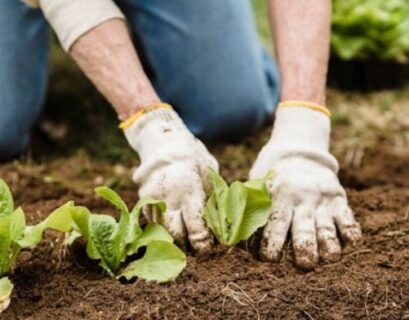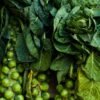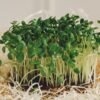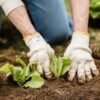Growing Brussels sprouts (Brassica oleracea var. gemmifera) takes a little longer than other vegetables but is very rewarding. The large leaves look much like their cousins, cabbage, cauliflower and broccoli and are edible.
But the main goal is to grow tasty shoots, like tiny heads of cabbage, just above where the leaves meet the thick stem. This guide will help you plant, grow and harvest Brussels sprouts in your garden.
Varieties of Brussels Sprouts
- Improved Long Island- (90 days) Developed in the late 19th century, it remains the most commonly grown heirloom variety. They are known for their excellent yield and good flavour.
- Catskill – (100 days) Developed in the 1940s, this open-pollinated variety produces abundant and extra strong stems. Sprouts are large, sometimes 2 inches in diameter, and great for freezing.
- Groninger – (105 days) A good choice for beginners, this variety produces crops even in variable weather. They are described as stubborn and have a delicate taste. Harvest after the first frost for sweet shoots.
- Red Ruby Brussels Sprouts – (90 days) A bright red heirloom that will add colour and variety to your table. They need cool weather to stay sweet and can be a bit snappy.
- Falstaff Brussels Sprouts – (102 days) A more reliable red/purple variety of Brussels sprouts. The buds’ veins and the leaves’ tips contain a blue-purple pigment. Colour intensifies after frost. Shoots are shorter than most green varieties.
Where to Plant Brussels Sprouts
Brussels sprouts grow best, like most vegetables, in full sun and moist, organic-rich garden soil. If your soil has a lot of clay or heavy, sticky sand that dries out quickly, add plenty of compost before planting. A relatively slow-growing vegetable, Brussels sprouts produce their best flavour in cooler weather.
How and When to Plant Brussels Sprouts?
Plant Brussels sprouts transplant into well-drained soil in the spring and watch them grow throughout the summer. Space plants 24 inches apart by 36 inches apart.
Because these plants mature slowly, if you plant seeds outdoors, you may not have enough time to develop a harvestable crop. However, if you live in an area with a long growing season, you can grow Brussels sprouts from seed.
Start seeds indoors about four weeks before your region’s average last frost date in the spring. When the seedlings are 4 to 5 inches tall, move them outside to harden off for a week. Then plant in the garden. If you live in an area with warm winters, you can plant Brussels sprouts in the fall and harvest them as a spring crop.
Planting Brussels Sprouts
Typically, between April and May, seedlings have 3 to 4 pairs of leaves, including the first seed leaf, so seedlings will be in their final position, in full sun and well-drained soil when transplanted. 60 to 70 cm distance. First, I cover the soil with a thick layer of peat-free compost to a depth of about 5 cm.
Brassicas are large leaf plants that need lots of soil compost and nitrogen to grow well. It will look like a big hole, but they will soon grow huge plants that need all the space. The photo below shows my plants eight weeks after planting, with leaves growing and filling in significant gaps.
I plant them in a grid so it’s easy to weed with a hoe and walk when I collect them later. Plants are spaced about 2 feet apart in rows. Small transplants will look sparse in rows with 2-foot spacing but don’t worry. They may not look oversized now, but they’ll need all that space by the end of the season.
Growing Brussels Sprouts in Containers
Brussels sprouts can be grown in containers if they have enough space. A pot should be at least 12 inches in diameter, and the soil should be 12 inches deep. A suitable container to use is a large container from a nursery plant, or a 5-gallon bucket will also work well.
Planting Brussels sprouts in containers allows you to extend the harvest period since the containers can be brought into a basement or closet. This will keep you harvested well into the winter and is an old technique for preserving Brussels sprout roots.
If you start planting Brussels sprouts in the garden, remove the roots and all after the first hard frost. Please put them in a bucket and take them inside. This will give you a few months to extend the season while you slowly harvest the last ripe Brussels sprouts.
Planting your Brussels sprouts in containers early on will produce indoors throughout January, even in colder climates.
How to Grow Brussels Sprouts
I didn’t eat Brussels sprouts growing up. I know this is one of those things kids are supposed to hate, but it never occurred to my parents to make anything other than canned corn or green beans. On extraordinary occasions, my mother would buy a can of asparagus.
In college, other kids experimented with all kinds of things, but one of my more “adventurous” friends introduced me to something that would change my life: Brussels sprouts. I know, not precisely racial, but I felt like my parents were hiding something from me. All these years, Brussels sprouts were there; they were delicious, and I had never known it.
This tiny spot of cabbage on a stem comes into my garden every year.
Brussels sprouts are members of the cabbage and kale family and are another variation in taste and growth habits. Like kale, the plant produces a single central stem and thick, cold leaves. A small cabbage-like head forms at each leaf junction and is the crop shoot.
How to Plant Brussels Sprouts

Once you’ve selected a variety of Brussels sprouts, it’s time to start planting. In areas with a short growing season, Brussels sprouts are best grown indoors in potting soil and transplanted outside in the spring.
They taste best when harvested after frost in the fall; unless started indoors, it’s still hard to get a harvest during our 100-day growing season in Vermont. We start them indoors 4-6 weeks before planting.
In warmer regions, Brussels sprouts are planted in the fall and grown through the winter months before being harvested in early spring. That way, they can grow in the colder months and be harvested before temperatures get too high. Ideally, they appreciate temperatures between 60 and 65 degrees for optimal growth.
Additional Tips for The Perfect Breakout
Fertilizer: A little fertilizer now and then in the summer won’t hurt. With enough compost mulch, Brussels sprouts don’t need it, but it will help increase yield, so I constantly water a little around the roots. I use it with organic seaweed fertilizer or homemade nettle fertilizer. It will be helpful to do this several times during the summer.
Remove old leaves: As they grow, the old leaves on the underside will turn yellow. Remove them with a gentle snap to the sides and compost. This opens up the area to more excellent airflow, prevents fungal infections, and gives birds of prey (if not covered) more room to fly and locate caterpillars. It also makes it easier to clean the weeds around the plant.
Please pick from the bottom: Instead of cutting the whole plant as you see in the store, cut the lower stems as needed. Plants still grow in winter, albeit slowly, so moving forward will spread your harvest.
Help plant in a windy location: Brussels sprouts become top-heavy with the weight of the leaves, raising the stem. Help them over winter by tying them up with a cane or sturdy stake.
How to Grow Brussels Sprouts From Seed?
Brussels sprouts seeds germinate best at temperatures between 45 and 85 degrees Fahrenheit. Sow seeds indoors in June. To start plants in containers:
- Gently press the seeds into a moist seed-starting mix.
- Keep the soil moist but not soggy, and put the container in a warm spot with bright, indirect light.
- Expect germination within about three weeks.
- Use sterile, soilless planting mix and press the seeds ¼ to ½ inch deep.
- Do not use low heat.
- The seeds should germinate in about two weeks.
Planting and Transplanting Brussels Sprouts
Use a loose organic vegetable potting mix for growing in containers. You can mix a little compost into the soil to improve its drainage and nutrient content. Repotting will not be necessary, as it is best to select a pot suitable for the plant’s mature size at the time of planting.
Spend the winter
Since Brussels sprouts are usually grown as annuals, they won’t need overwintering. Just plant early enough to harvest your area before freezing temperatures hit.
Common Plant Pests and Diseases
Brussels sprouts are prone to the same problems as other cabbage plants. The most common pests are cabbage worms, cabbage rootworms, and aphids. Consider using row covers to protect your plants.
Several fungal diseases can also affect Brussels sprouts, such as black rot, club rot, downy mildew, and white mould. Proper air circulation around plants can help prevent fungal problems. If plants become diseased, it is usually best to destroy them.
FAQ
Do Brussels Sprouts Grow Well in Containers?
If you don’t have a suitable garden location for Brussels sprout plants, growing them in containers can be a good option. This will allow you to control your plants’ sunlight, water and soil. Choose a container that is at least a foot wide and deep. It should have ample drainage holes.
What is The Secret to Growing Brussels Sprouts?
Check the soil moisture regularly and give the plant 1 to 1.5 inches of water each week. Encourage Brussels sprouts to produce bountiful harvests by periodically feeding them nutrient-free plant food. Place a 3-inch layer of mulch to retain soil moisture and prevent weeds.
What Month is Brussels Sprouts Planted?
Sow the seeds from March to early May in prepared soil (see above), under cloches or sheep if the weather is still fantastic. Brussels sprouts are traditionally sown in a separate “hotbed” rather than in the main vegetable patch and then transplanted in early summer when more space is available.
What Size Container Do You Need to Grow Brussels Sprouts?
Here’s how to grow Brussels sprouts in pots: Find a pot at least 1 foot wide and deep with plenty of drainage holes. A large pot, or even a 5-gallon bucket with a hole in the bottom, can work well. Use composted soil with compost to ensure quick drainage.
Do Brussels Sprouts Have Deep Roots?
Brussels sprouts have shallow roots that require fertile soil, so amend the soil with compost before planting. Like other brassicas, they need full sun (at least six hours of direct sunlight) and well-drained soil.
Can Brussels Sprouts be Grown Indoors?
If you live in an area with cold winters, you can sow seeds indoors about two to three weeks before the last spring frost. It’s easy to make and will give you a head start on the growing season. First, choose an indoor location with a temperature of about 77 degrees and plenty of light.









